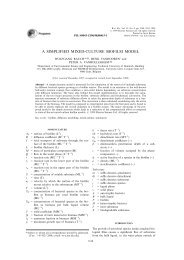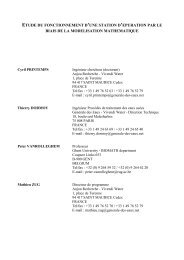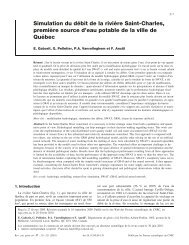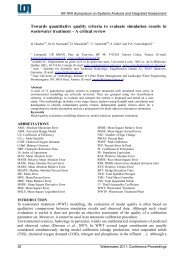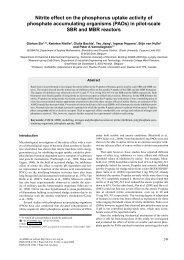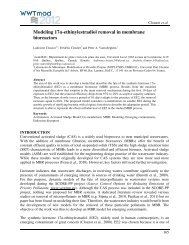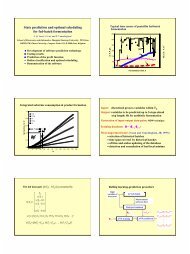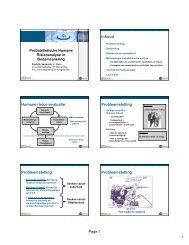Optimal control of the penicillin G fed-batch fermentation: An ...
Optimal control of the penicillin G fed-batch fermentation: An ...
Optimal control of the penicillin G fed-batch fermentation: An ...
Create successful ePaper yourself
Turn your PDF publications into a flip-book with our unique Google optimized e-Paper software.
PENICILLIN G FED-BATCH FERMENTATION 15statement <strong>of</strong> <strong>the</strong> complete optimization problem. We also formulate <strong>the</strong> basic conjecture <strong>of</strong>this paper. In Section 3 we develop for <strong>the</strong> first time <strong>the</strong> optimal feed rate pr<strong>of</strong>ile maximizing<strong>the</strong> final amount <strong>of</strong> product, in verifying <strong>the</strong> statement by Heijnen et al. that <strong>the</strong> glucose feedscheme is <strong>of</strong> crucial importance in obtaining high <strong>penicillin</strong> yields. Section 4 presents a physicalinterpretation <strong>of</strong> singular <strong>control</strong>, based on a ma<strong>the</strong>matical analysis <strong>of</strong> <strong>the</strong> optimal <strong>control</strong>solution. In Section 5 we derive a suboptimal strategy based on ma<strong>the</strong>matical and microbialknowledge, that is found to be a useful alternative for <strong>the</strong> optimal open-loop feed rate pr<strong>of</strong>ile.It opens perspectives for more reliable, adaptive, model-independent <strong>control</strong> schemes. Someconclusions are formulated in Section 6.Apart from <strong>the</strong> derivation <strong>of</strong> optimal <strong>control</strong> pr<strong>of</strong>iles for this model - which are importanton <strong>the</strong>ir own - we believe that <strong>the</strong> most important contributions <strong>of</strong> this paper are <strong>the</strong>following. The realizable gain due to feed pr<strong>of</strong>ile optimization is in <strong>the</strong> region <strong>of</strong> severalhundred per cent. Fur<strong>the</strong>rmore, <strong>the</strong> model is very sensitive towards different feeding policies.These results, toge<strong>the</strong>r with <strong>the</strong> fact that <strong>the</strong> commonly observed biphasic behaviour <strong>of</strong> <strong>the</strong><strong>penicillin</strong> <strong>fed</strong>-<strong>batch</strong> <strong>fermentation</strong> has disappeared after optimization, raise some questionsconcerning <strong>the</strong> validity <strong>of</strong> this model. In this way this optimal <strong>control</strong> study can prove to bevery useful for model discrimination purposes: optimization for model discrimination. Formore details see Reference 4. Secondly, <strong>the</strong> heuristic <strong>control</strong>lers introduced in Section 5 havean excellent performance in all cases. Moreover, since <strong>the</strong> <strong>control</strong> objective (namely to keep<strong>the</strong> specific growth rate constant during <strong>the</strong> production phase) is obtained independently <strong>of</strong> <strong>the</strong>exact analytical expressions for <strong>the</strong> specific rates, <strong>the</strong>se <strong>control</strong>lers can serve indeed as a basisfor <strong>the</strong> development <strong>of</strong> model-independent <strong>control</strong> algorithms. This is elaborated in detail inReferences 3 and 4: optimal adaptive <strong>control</strong>.2.1. The original model equations2. THE MODEL OF HEIJNEN ETAL.Heijnen et al. used <strong>the</strong> following steps in <strong>the</strong> construction <strong>of</strong> a simple unstructured modelfor <strong>the</strong> <strong>penicillin</strong> G <strong>fed</strong>-<strong>batch</strong> <strong>fermentation</strong> process: (i) definition <strong>of</strong> relevant compounds in <strong>the</strong><strong>penicillin</strong> <strong>fermentation</strong>, (ii) specification <strong>of</strong> chemical composition and specific enthalpies, (iii)formulation <strong>of</strong> elemental balances and <strong>the</strong> enthalpy balance (one <strong>of</strong> <strong>the</strong> most interestingfeatures <strong>of</strong> this approach), (iv) formulation <strong>of</strong> mass balances for individual compounds, (v)formulation <strong>of</strong> <strong>the</strong> weight balance and (vi) selection <strong>of</strong> <strong>the</strong> kinetic equations (in this case basedon a literature survey). Their research resulted in <strong>the</strong> following continuous-time model which<strong>the</strong>y believe to be <strong>of</strong> great possible help in <strong>the</strong> optimization <strong>of</strong> <strong>the</strong> process:dSdX-= -ux+u, - = px, -= dPdt dt dt?rx-khPwithSXPG-=- dGdtCs,inu - 0-OOO8G - O-044rc + 0*068rn + 0*392rs, + 0-032r0 + 0.687rXamount <strong>of</strong> substrate (glucose) in broth (mol)amount <strong>of</strong> cell mass in broth (mol dry weight)amount <strong>of</strong> product (<strong>penicillin</strong>) in broth (mol)total broth weight (kg)(1)



